 |
 |
![]()
| HOGG TULLOCH GRAHAM HEUZE (TIM) TX2185 CAPTAIN MEDICAL OFFICER |
| 13 AUSTRALIAN GENERAL HOSPITAL - MALAYA - SINGAPORE - BURMA THAILAND RAILWAY |
Tim (he was a tall man and Tim was a contraction from his nick name
"Tiny Tim") Hogg was borne in Launceston, Tasmania on 11 June
1906. Following secondary school he studied to be a doctor
and graduated in 1931. He later travelled to Edinburgh
University to continue his studies. Whilst there he attained
Fellowship of the Royal College of Surgeons (FRCS) and Post War he
attained Fellowship (FRACS) in Australia (see end of article).
Captain Hogg was one of eight Australian Medical Officers who were sent
to Thailand as members of K and L Force. These two forces
were tasked to keep the Japanese Coolie labourers, numbering around
250,000, alive. This was an impossible task and it is
estimated that around 90,000 of the coolies died.
The Australian Medical Officers who formed part K and L Force were -
| "K" Force | |||
| Anderson BH | Major | DADMS | VX47449 |
| Davies GFS | Major | 2/13 AGH | NX76351 |
| Hogg TH | Capt | 2/13 AGH | TX2185 |
| Frew JK | Capt | 2/13 AGH | VX39181 |
| Drevermann EB | Capt | 2/13 AGH | VX61260 |
| "L" Force | |||
| Andrews HL | Major | 2/10 AGH | VX39316 |
| Murphy PF | Major | 2/10 Fd Amb | NX70489 |
| Crankshaw TP | Major | 2/13 AGH | VX62081 |
I am grateful to Mrs
Jenny Blencowe and Mrs Susanna Allen, the late Tim
Hogg's daughters, who have given me permission to publish the following
extract of 20 pages from a family history titled "An Early Tasmanian
Story".
PRE
WAR YEARS
Tim Hogg had been a cadet at Geelong College and later was a member of
the Melbourne University Regiment (M.U.R.) when he was a medical
student at the University, graduating M.B.B_S. in 1931. In May 1939,
whilst he was at the Launceston General Hospital, he had been made an
"Honorary Captain", in the Army Reserve. Tim remained as an
Outpatients Honorary Surgeon in the Launceston General Hospital until 1
August 1941 when he enlisted in the Australian Army with the rank of
Captain.
With the commencement of the Second World War in September 1939,
Australia formed three army divisions, the 6th, 7th and 9th, which were
sent to the Middle East for fighting in the Western Desert, Palestine
and Syria. The 8th Division was formed at the end of 1940 but was not
fully trained or equipped, and had no combat experience. By early 1941,
the allied forces were very much on the defensive and the military
forces available in the Far East had not been strengthened and had
effectively been run down. In a general strategic assessment of the Far
East in early 1941 it was realised that the Far East and the South West
Pacific areas were critical to the defence of Australia and that there
were inadequate military forces to meet the situation.
8th DIVISION TO MALAYA/SINGAPORE
The recently formed 8th Division was assigned to Malaya and elements of
the Division left Sydney in early February 1941, including a number of
medical units. The medical units, as such, were well organised with a
structure which included Casualty Clearing Stations, Field Ambulances,
Field Hygiene units, Convalescent Depots and a full General Hospital.
The general hospital included all normal facilities such as doctors,
nurses, dentists, surgeons, X-Ray units, pathologists together with a
large range of medical stores. The Australian General Hospital (A.G.H.)
which was initially set up with the 8th Division in Malaya was
designated 10 A.G.H.. This general hospital was adequate for the
initial 8th Division units deployed, however it was not adequate in
size for the full division when it was fully deployed; accordingly a
further general hospital was raised and equipped in Australia in mid
1941, this was designated 13 A.G.H. This was the unit to which Tim Hogg
was assigned. He departed from Melbourne on the H.M.A H.S. Wanganella
on 2 September 1941 and arrived in Singapore on 17 September.
As 13 A.G.H. was a new unit and inexperienced in the tropical
conditions of Singapore and Malaya, there was an interchange of staff
between the existing 10 A.G.H. and 13 A.G.H. and 13 A.G.H. was then
commanded by a member of 10 A.G.H. The hospital was originally sited at
St. Patrick's School on Singapore Island, to the east of Singapore
city, but with the final allocation of the responsibility of the 8th
Division to the defence of Johore and Malacca in the southern part of
the Malay Peninsula, the hospital moved from Singapore Island to
Tampoi, seven miles from Johore Bahru in a partly completed mental
hospital on 8 December 1941, the day after the Japanese attacked Pearl
Harbour and simultaneously attacked the northern Malay Peninsula. The
10 A.G.H. was sited further north at Malacca in part of the Malacca
hospital.
By early January with the rapid Japanese advance down the Malay
Peninsula and the Australian forces becoming heavily engaged, the 10
A.G.H. was forced to withdraw to Singapore Island. The 13 A.G.H. was
itself forced to withdraw to Singapore Island by the end of January,
this involved the immense task of moving a fully equipped general
hospital with 1,200 beds; the site of the hospital was taken over by a
Casualty Clearing Station and it appears that Tim Hogg remained behind
with the Casualty Clearing Station to attend the wounded soldiers. The
Casualty Clearing Station was the last of the medical units to withdraw
to Singapore Island and Tim was one of the last to cross over the
causeway from Jahore to Singapore Island before it was blown up.
The 13 A.G.H. was relocated to the St. Patrick's School where the work
load was extremely heavy with a very large number of battle casualties.
Tim, as part of the surgical staff worked from 8 P.M. to 8 A.M. in one
of four hastily set up operating theatres, each with two operating
tables and two surgeons to each table. The conditions of working he
described as a "very hot and stuffy atmosphere". Up to this time there
were a large number of female nursing staff in the hospitals, these
were withdrawn and all evacuated from Singapore by 14 February, this
loss of experienced nursing staff placed a great strain on the hospital
as they had to be replaced with relatively inexperienced male staff.
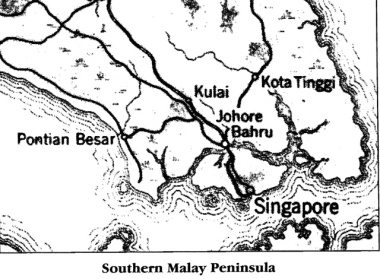
The Japanese invaded
Singapore Island and there were heavy air attacks
on military installations. The Island's water supply came principally
from Jahore across the Causeway and this was cut off, causing
significant problems in the hospitals. The Japanese advance caused many
further battle casualties, and eventually the St. Patrick's School
hospital site ended up in "No Mans Land" with artillery firing from
both sides over the hospital. The firing suddenly stopped and it was
realised the Allied forces on the Island had surrendered. Captain Tim
Hogg became a Prisoner of War on 15 February 1942 along with 15,000
other Australians. At the time of the surrender, the status of various
personnel in the various Australian units was obviously uncertain, as
the Central Army Records Office was not informed whether he was a
prisoner of war, so that after the surrender Tim Hogg was recorded as
missing in his military record, dating from 16 February 1942, his Next
of Kin were notified on 19 April that he was "Missing presumed dead".
Normally, the International Red Cross would have obtained the names of
all Prisoners of War from the Japanese command and duly notified the
Australian authorities. It was not until 7 January 1943 that the
information that he was a Prisoner of War finally reached Australia,
that he was "interned Malayan Camp". In this intervening period his
daughter Jenny, who was nearly five years old at the time, remembers
that she really believed that they could dig through the earth and
reach him on the other side; she also told imaginary stories to her
brother and sister that he was coming home.
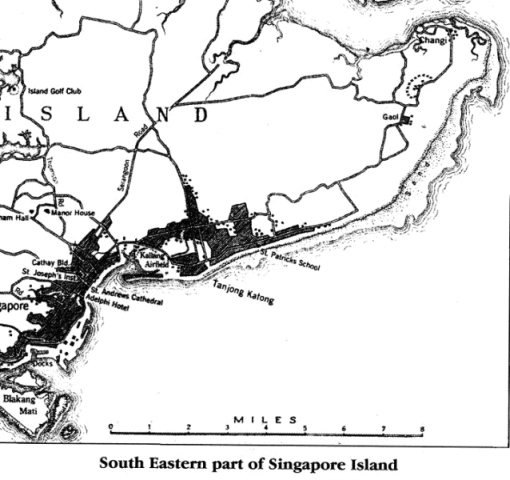
With the surrender, the
Japanese kept the allied force structure
intact, with all the usual military command structure functioning;
effectively, the only major change was the removal of the higher level
general staff officers to Japan. The Japanese forces proved quite
unpredictable, and the Australian hospital staff were very worried
after the Japanese forces stormed the British military Alexandra
Hospital killing most of the staff and patients.
Within days after the capitulation, the Japanese ordered that all sick
and wounded on Singapore Island (9.000 in all) were to be moved to
Changi on the eastern tip of the Island, the Australians being
allocated the Selarang Barracks area. Only a week had been allocated
for this move, with virtually no transport. Eventually, this was strung
out to three weeks, but still the problems of the move were immense and
the Japanese tried to restrict the move of medical equipment and
supplies.
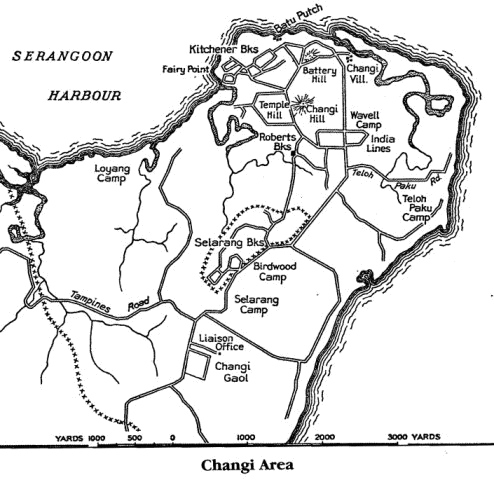
ROBERTS BARRACKS ALLIES GENERAL
HOSPITAL
Within weeks, the Japanese ordered that all the prisoners' hospitals
were to be combined together as a common hospital in a separate
location in the Changi area, called the Roberts Barracks.
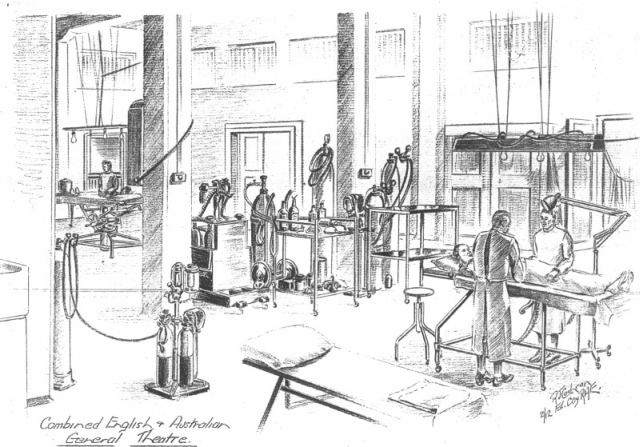
This move and the
creation of a common hospital caused many
difficulties but this was eventually overcome. Sanitation proved a
major problem as the hospitals had great difficulty in maintaining
adequate water supplies and the general soldier camps had little in the
way of sanitation and washing facilities. This took many months before
it was brought under adequate control, meanwhile dysentery and similar
sanitation diseases became a significant problem. This came to a head
in late August 1942 when, following the attempted escape of some
prisoners, (who were subsequently executed) the Japanese demanded that
all troops should sign an undertaking that they would not escape. This
naturally caused much disturbance among all prisoners and acting on
command instructions, they all refused to sign the undertaking.
SELERANG BARRACKS INCIDENT
The Japanese response was to move all the troops to the Selarang
Square, where there were three building floors and an area of 800 by
400 feet. Tim Hogg well remembered this incident and the appalling
sanitation problems from the confinement of over 15,000 troops in such
a small space. Diphtheria and dysentery broke out, and the Japanese
threatened to halve the rations of the troops. Eventually, a compromise
was worked out and a carefully reworded document produced which enabled
the Japanese to save face, and the prisoners were told by their
officers to sign under duress.
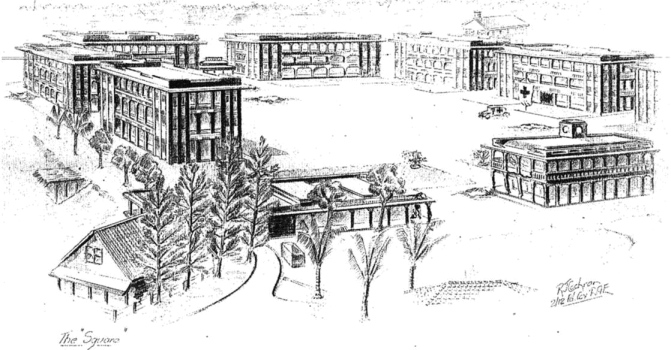
With all the forces back in their assigned barracks, the medical staff
resumed their difficult tasks in rather adverse circumstances. The
problems faced are documented in various histories, however they are
well described as follows:
As soon as the forces moved to
the Changi area both preventative and
curative medicine assumed the greatest importance. The magnitude of the
obvious task of the medical services, that of curing the sick was
subject to more than usual fluctuations. These were owing, in the first
place, to the number of casualties from combat and disease that
represented a legacy from the Singapore battle. Next there was a rise
in illness due to infective and nutritional causes, arising within the
concentration area itself. This varied from time to time, partly owing
to the upsurge and subsidence of ordinary and prevalent or epidemic
diseases, some of which was preventable. During the first months, the
commonest diseases in Changi were disorders of the skin, dysentery,
other digestive troubles, and to a lesser extent respiratory diseases.
Typhus and malaria mostly contracted before capitulation were also seen
in hospital and diphtheria appeared, though in fewer numbers in the
A.I.F. than in the British force. Another reason for the rise and fall
in illness was related to the nutrition of the men; malnutrition was a
constant menace throughout the whole force, and varied in degree with
the ration supplied and the supplements that could be procured or
devised. Finally, the amount and to some extent the type of illness
occurring in Changi depended upon the military population itself, which
fluctuated considerably.
All prisoners, whatever their rank, were regarded by the Japanese as
labourers and were used as such for various work around Singapore. Tim
Hogg was not immune from this work and spent a considerable amount of
time unloading ships and other related work. This did however have some
consolation as there was always the opportunity for scrounging
additional food or other items. They managed to sell some items, such
as rolls of silk to the local Singapore people, but they always had to
be very careful.
Tim felt that life in Changi, was not too bad; there was an organised
social life, with lectures by the large number of experts in virtually
every field including artists, lawyers, eye specialists, nutrition
experts etc. One artist prisoner specialised in making miniature
playing cards which were decorated by the artist; the Queens of Hearts
and Diamonds were glorious blondes, the other cards were appropriately
decorated. Tim had a set of these cards throughout his entire
imprisonment, but threw them away at the end as they were so dirty and
worn out.
WORKING PARTIES (FORCES)
DESPATCHED FROM SINGAPORE
In March 1942, the Japanese began to send out working parties into
different parts of Singapore Island and the neighbouring mainland and
in May, a series of overseas and up country working parties were sent
away. These varied in size from small parties to large forces of
several thousand; some returned after a time, others, bound for more
distant destinations never returned.
These various working parties which left Singapore were known as
"forces", Australian prisoners of war were sent from Singapore to:
o Burma A
Force.
o Thailand D, F, H Forces and K and L
Forces (medical forces).
o Japan C,
G and J Forces; Senior
Officers Party.
o Borneo B and E
Forces.
o Manchuria, Indochina, Formosa and Korea.
In addition a Force called Dunlop Force went to Thailand from Java.
After the Japanese over-ran Thailand, Indo China, Malaya and Indonesia,
they continued their strong movement to the south and in addition, they
mounted a major attack on Burma and from Burma they intended to
over-run India. They had a major supply problem in their assault on
Burma and India as they desirably wanted to avoid the long sea route
around the Malay Peninsula. The best port facilities were at Bangkok
but there was no suitable road or rail route through the mountains into
Burma.
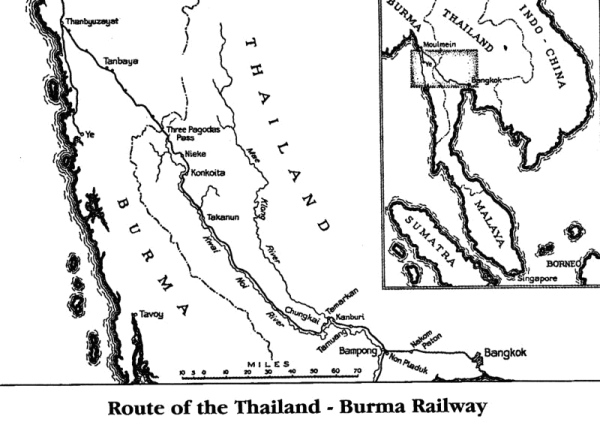
The Japanese felt that
they could construct a railway, given that they
had a cheap labour force available, in the form of the prisoners in
Changi and other locations. This route could then link up with the
existing railway which ran from Singapore to Bangkok and also with the
railway systems which ran the full length of Burma. The route of this
new railway ran from Bangkok on the east bank of the Mae Khlong River16
until it reached the Kwae Noi River, it then crossed the Mae Khlong and
followed the east bank of the Khwae Noi into the mountains to the north
west and cross the mountains at Three Pagoda Pass. It then followed
down into Burma through the mountains to Thanbyuzayat. The presence of
the rivers enabled an easy supply route for the work forces which were
established at various camps along the route of the railway. The
proposed railway was 270 miles long and ran through dense uncleared
forest for most of the way, with many deep cuttings and embankments and
about 700 bridges.
In May 1942, the first Australians left Changi to work on the line,
these were designated A Force, they went by ship (often called Hell
Ship) to Burma for work on the railway. It was not until January 1943
that Australian units were moved to Thailand for work on the railway,
the first to arrive was Dunlop Force, which was commanded by Weary
Dunlop; this force came from Java and the experiences of this force are
graphically told by Weary Dunlop in his published diaries. Later
Australian forces then left Changi for work on the railway.
It would not be appropriate here to go into detail on most of these
construction Forces, sufficient to say that they worked under the most
appalling conditions, with Japanese construction supervisors who had
only one requirement - to complete the railway in time for a Japanese
offensive in Burma; the welfare and life of the construction workers
was of minor or no importance. Malnutrition was a way of life,
exhaustion and tropical diseases were endemic and the loss of life very
great. In all, approximately 62,000 British, Dutch and Australians
worked on the railway in the various camps, of these there were over
12,000 deaths, about 20%.
By March 1943, it became apparent to the Japanese that they would need
many more labourers to work on the railway construction and they
commenced advertising in the Malayan newspapers for coolies to work for
periods of three months in Thailand. Free rail travel, housing, food
and medical services were said to be provided and the pay offered was a
dollar a day. Few coolies responded to these advertisements so the
Japanese resorted to "Press Gang" methods, with armed Japanese visiting
each kampong or village and demanded at least 50% of the male
population. The promised three months contracts were worthless and no
coolies returned to their homes in the first 18 months. The total
number of coolies actually moved to Thailand is uncertain; the numbers
were estimated as at least 250,000. Of these coolies the Japanese
admitted to 90,000 deaths; Australian medical staff who worked closely
with the coolies place the figure for deaths up to December 1944
between 150,000 and 200,000.
The military units which were employed on the railway construction
maintained their cohesive organisational structure, and in addition had
formal medical units. Even given the appalling conditions under which
they worked, they still were able to enforce some semblance of hygiene
discipline and some control over diseases. They also had an
organisation which was able to argue with the Japanese for better
conditions and some additional food; they achieved slightly better
conditions
To construct the railway, a number of camps were established along the
route from Thailand to Burma. Many of these camps were for prisoner of
war units, whilst a separate series of camps were established for the
coolies. Each of the prisoner of war camps usually had some form of
medical establishment which was based upon a military structure, so
that attempts could be made to enforce the most basic forms of hygiene.
This was often extremely difficult given the conditions. Medical
facilities were generally very primitive and the necessary medical
equipment often had to be hand made. Food was generally in short supply
and usually based upon poor quality rice. Following experience in
Singapore, extra necessary food supplements were often found by local
purchase; even then there were many cases of disease which could be
attributed to malnutrition.
In the coolie camps, conditions were quite different as the coolies
came onto the railway with no organisational structure, whilst the
Japanese seemed to adopt a policy of doing nothing and tended to regard
the coolies as expendable items. To complement the field medical teams,
some base hospitals were established for the prisoners and also some
facilities for the coolies.
"K" FORCE TO THAILAND
By May 1943, the Japanese realised that the wastage in the coolie camps
was so high that they instructed the Prisoner of War Command in Changi
to provide medical parties to proceed to Thailand. They were not really
specific on what their function was, all they indicated was that the
party was to be called "K Force". It was to remain under the general
administration of Singapore; it was to be employed in the treatment of
sick Prisoners of War and was to be divided into sections on arrival at
its destination to staff already established hospitals. The Japanese
also said that no medical supplies were to be taken, as adequate
supplies were available in the hospitals.
The Prisoner of War command heard from their own sources in Thailand
that cholera, dysentery and malaria were prevalent in Thailand, so that
quantities of appropriate drugs were taken by K Force. Lieutenant
Colonel Glyn White, who was the chief Australian Medical Officer, asked
Tim Hogg to join K Force. The Force in all totalled thirty medical
officers and two hundred orderlies, of which there were five Australian
medical officers' and fifty medical orderlies. The Force left Changi
for Thailand on 25 June 1943 in closed steel rice trucks, 24 to 28 per
truck, plus a Japanese sentry. The rail journey took eight days from
Singapore to Kamburi in Thailand. Rations on the journey were very poor
with two meals of rice and stew per day, They had very little drinking
water and no ablution facilities. They were able to make local
purchases of food en route at various stations. When they arrived at
Kamburi, they were marched to the Japanese Headquarters where they were
searched and all bulk medical supplies, Red Cross food parcels and
reserve rations were confiscated; fortunately, many of the medical
supplies had been distributed among all members of the force so that
they were able to retain some quinine, atebrin and sulphanilamide
tablets.
They then had an address from Colonel Hayakawa who commanded the
Sanitary Corps of the Bangkok to Moulmein Railway Construction Group.
Colonel Hayakawa was responsible for the medical, hygiene and
sanitation services along the line. He delivered a speech to the effect
that all the great engineering achievement of the world had been
carried out in the face of tremendous medical problems; success or
failure depended on the ability to cope with disease. Already, there
had been much sickness on the railway and many deaths. He said that it
was the duty of K Force to prevent this, but before they could carry
out this work he had to be satisfied that the medical party had
sufficient knowledge. All officers were required to undertake a medical
exam. Whilst the questions were simple, Tim felt that he could not
answer them properly however he, like every one else (including two
dentists) passed with flying colours. The members of K Force then
realised that their real job was not to provide medical services to
military personnel, but to provide medical services to the coolies.
K Force was then divided into three groups, one party to remain at
Kamburi where a new hospital was being set up, one party, including Tim
Hogg was to go to Wanye, another party, including Jock Frew were to go
to Nike. Prior to leaving Singapore, Tim, with foresight, asked his
commanding officer, Lt Col Glyn White for enough spinal anaesthetic to
last a couple of years. He was therefore able to operate during the
next P.O.W. years. The Wanye party left Kamburi on 5 July in open
trucks and bivouacked on an area in the rear of the local coolie camp
which was heavily contaminated with human faeces. As the trucks were
being loaded, Tim recorded that there were many Thai locals standing
around quietly. As the trucks moved off, the Thai locals threw in
bunches of bananas and then ran off. The P.O.W.'s were most grateful
for the food. The Wanye party was then detailed for duty at various
construction centres along the line. The various medical groups
generally operated alone or with some other groups, from Kamburi
through to Tanbaya which was 40 kilometres south of Moulmein in Burma.
An additional Force was created from Singapore in August 1943, termed
"L Force", this was similar to K Force, however it tended to be used in
the base hospitals rather than in the field.
Theoretically both K Force and L Force were under the command of
Singapore, whilst most other Prisoner of War Forces were under the
command of the Thailand Prisoner of War administration. The consequence
of this was that those under local Thailand command received better
consideration in all matters of supply, rations, pay and mail. K Force
personnel were dependent entirely upon themselves and on the Japanese
controlling the various camps to which they were attached. The majority
of the Force were assigned to coolie camps "to provide medical
attention and supervise hygiene and sanitation in the camp". Rather
than forming a hospital as they were told, Tim found himself looking
after the coolies.
COMMENT FROM THE WAR DIARIES OF
WEARY DUNLOP
When Weary Dunlop heard that Tim Hogg and others had come up to
Thailand from Changi, he rather unfeelingly commented in his diary
"They are all acting as MO's to the Tamil camps with little to do
except to make hygiene rules and bury the dead. In companionship I
suppose, nothing but the Nipponese - what a life!"
Little did he seem to realise the most difficult conditions under which
members of K Force had to work to provide even the most basic medical
facilities. In general, the medical staff of K Force who worked up the
line in the coolie camps, worked under far more trying conditions than
any other medical staff in Burma and Thailand.
For the first few months, they found that supplies of drugs were either
nil or totally inadequate; diseases in virtually all forms was rife,
particularly cholera, dysentery, malaria and tropical ulcers. Rations
were very poor, including poor quality rice and dried fish. Within a
few weeks vitamin deficiencies began to appear, particularly beri-beri
consequent mainly from the lack of vitamin A. Essentially, all that Tim
had to treat the coolies with was quinine for malaria, condies crystals
(potassium permanganate) to treat tropical ulcers and rough bandages
made from split bamboos, and boiled up old clothing removed from the
dead. The Japanese engineers' attitude was that every man who could
walk was to work on the railway and that no labour was available for
normal camp duties such as hygiene work and hut building. The coolies
themselves had little idea of sanitation, so that a typical coolie camp
at this time consisted of tumble down shelters in a midst of mud,
excreta and food refuse, all of this in the midst of heavy monsoon
rain. Tim and the others had individual clothing problems as they had
no replacement for their clothes which suffered hard wear, so for
normal travelling between the various camps, he used a G-String instead
of his shorts; on his arm, he wore a Red Cross sign (brassard). This
proved valuable one day as he was walking along a road between the
camps, and a car passed him with Japanese officers, they thought that
he was trying to escape! He only convinced them by pointing to his Red
Cross sign and showing them the contents of his rucksack.

Food supply was always
a problem and was not helped by the fact that
food for the camps up the line in Thailand was generally supplied by
barges on the river which unloaded at the various camps. What they
found was that in the more distant camps, if they were to receive say
six bags or rice, then much was stolen on the way so that very little
was left for the most distant camps.
Even given their lack of medical supplies, the members of K Force who
were working in the Coolie camps did much to alleviate the suffering of
the coolie by making the maximum use of anything available. They used
bamboo for many purposes such as building, furnishing, eating utensils,
bed pans, bowls, instruments etc. Wild spinach and other native shrubs
were collected for use in the treatment of vitamin deficiency diseases.
The medical officers supervised the creation of isolation areas and
latrines and the provision of boiled water for the sick coolies. All
this work was much appreciated by the coolies who looked after the men
of K Force and showed great generosity with gifts of food etc. on a
reciprocal basis.
The members of K Force had very few medical instruments as most of
these had been taken from them by the Japanese when they arrived at
Kamburi. On one occasion, Tim was visiting an Australian camp where
there was no medical officer and found a patient with an acute appendix
which needed an operation; Tim did not have suitable instruments or
gauze. There was a British camp close by which had just received a Red
Cross parcel of medical equipment. The British Colonel in charge was
quite willing to give Tim some of this equipment if he could get them
past the guard. Tim took special precautions to wrap bandages and gauze
around his body and to hide the instruments under cotton wool in his
knapsack. The guards found some of the gauze and cotton wool and were
annoyed with him, and as he left the camp, they trained their machine
guns on him; eventually, he managed to get away from the camp with his
extra equipment. When he got back to the Australian camp, he removed
the appendix with the help of a Doctor Lewis. Despite the rather
primitive operating conditions, the patient lived.
Tim Hogg had his own personal health problems as he was exposed to so
much in the way of serious disease; he said that he had virtually every
tropical disease imaginable at one time or other. All of K Force
suffered from malaria, most, including Tim, from dysentery, beri beri,
dermatitis and many with tropical ulcers. At one time, Tim received a
very badly infected finger which really required opening and draining;
he did not have any surgical instruments and eventually found a British
doctor who administered an anaesthetic and performed an emergency
operation on the side of a road, which required him convalescing in a
nearby Australian camp.
Jock Frew (Captain - Post War Sir Jock Frew) who was a Victorian doctor
in K Force was more fortunate than Tim as he was attached for about a
year to a Japanese mobile bacteriological unit. Once when Tim was
moving between the various coolie camps, he heard that Jock Frew was
further up the river, but not too far away. They were able to meet a
number of times by Tim swimming up the river; after they met a number
of times, they felt that it was too risky to meet further in this way.
Tim worked at a number of camps from Kamburi in Thailand right up the
line to within a few miles of Moulmein in Burma. In September 1943, a
sick camp was formed at Kamburi for men of F and H Forces. Tim then
with orderlies from K and L Forces did much of the work in setting up
this camp. The camp was formed to receive sick men arriving from the
upper sections of the line. Many of the men arriving were in very bad
condition and many of the medical officers and orderlies of these
groups were sick and exhausted. K and L Force personnel under Tim's
leadership took over the medical duties as far as possible and
contributed a great deal towards the establishment of a satisfactory
camp and medical services. Later, Tim worked in the Japanese laboratory
at Kamburi doing routine bacteriological work for the various camps in
the area, he also worked for short times in two Japanese 25 bed
hospitals. The line itself was completed in mid October 1943 and the
numbers for work on the line decreased significantly. There was also a
change, in administration on the line from the very difficult and
demanding Japanese construction engineers to the local Japanese
Thailand administration. This did alleviate the food situation, but it
was still very difficult for the various prisoners and coolies.
MANY AUSTRALIANS RETURN TO
SINGAPORE - BUT NOT 'K' AND 'L' FORCE
Many of the Australians working on the line had gradually been returned
to Changi from the end of 1944 and early 1945; it had been intended
that both K and L Forces should return at the end of December 1944
however, because of Allied air attacks on the bridges along the railway
line, this did not take place. These air raids caused much trouble to
the prisoners, not so much from the bombing, which was very accurate
and avoided their camps, but from the consequential reduction in food
supplies by the Japanese.
1945
There were a number of moves on K and L Force personnel during 1945 to
various camps, the final move was to Takri which was 180 miles north of
Bangkok on the Cheng Mai railway line. It took the 8 medical officers
and 90 other ranks, five days to make the journey with about 1,000
other prisoners to reach the new site, where they found that the
Japanese were constructing an air strip. On the way, Tim remembered
that they slept in caves with many monkeys hopping about. As usual,
they found that the accommodation and facilities were totally
inadequate, with no hospital facilities, poor hygiene facilities and
limited water supply. The area was highly malarious so that the sick
wastage was very high. The medical staff had to build an operating
theatre, dispensary and medical inspection block, together with a
hospital block in addition to caring for 350 sick personnel plus 500
daily treatments at the medical inspection block. Tim carried a
complete surgical kit to Takri as the surgical specialist in the party;
upon his arrival, these were seized by the Japanese and despite
protests these were never returned; an emergency set was created from
the various instruments held privately by individual officers.
Supplies of food and drugs became a major problem as much had to come
from Bangkok and many bridges were destroyed by air attacks. This
situation continued right up to the Japanese capitulation on 15 August
1945. Although the prisoners had stopped work, they were not told the
reason by the Japanese. After a few days, the location of the Takri
camp was found by the Allied forces and Tim remembered two British
paratroopers walking into the camp saying, "Boys the war is over, you
are free to disarm the Japs." After a few more days, whilst Tim was
treating leg ulcers, an Australian Air Force officer came up from
Bangkok. Tim knew him from Geelong College, it was Jos. Bell who had
been Head Prefect. He collected the names of all personnel in the camp
and ensured that the names were passed back to their respective
countries saying that they were alive.
Unfortunately, all the medical records of K Force were confiscated by
the Japanese so that full details of their medical conditions were
lost; it appears that the Japanese destroyed these along with most
other K and L Force records. Takri received a number of ex prisoners
from outlying camps, two of whom were found to have smallpox. The camp
was then quarantined and although some evacuations had commenced,
further evacuations were delayed for fourteen days. Finally, K Force
was evacuated to Bangkok and effectively ceased to function as a
medical unit as medical units from the incoming 7th Army in Burma took
over responsibility. After his captivity, Tim weighed about seven stone.
The official report on K Force ends as follows:
Throughout
the time in Thailand all ranks of K Force behaved in an
exemplary manner. It was anticipated that the long periods of isolation
in coolie camps which many members experienced would have had an
adverse effect on both discipline and enthusiasm for work. This was not
so; when the Force came together again and had the opportunity of
performing duties for which it was formed, it carried them out
efficiently and willingly, even under the most adverse circumstances.
Special mention should be made
of the work performed by Captain T.C.
Hogg and Captain J.L. Frew.
Captain Hogg was surgical
specialist in K Force and functioned in this
capacity throughout the period when K and L Forces were together at
Kamburi, Tamuan and Takri camp. Although experiencing indifferent
health, his work often carried out under the most difficult conditions
was outstanding.
Captain Frew showed great
qualities of leadership as OC Nike party
during the march from Kinsick (Kinsayok) to Nike. Later, as medical
specialist and medical officer in charge of the hospital at Takri, he
rendered invaluable service.25
REPATRIATION TO AUSTRALIA
Although the Japanese had capitulated in mid August, it was some months
before Tim actually was able to find a way back to Australia. Tim flew
from Bangkok to Singapore and found that he could not obtain further
clothing, also that he would have to queue for an aeroplane or go by
boat to Australia. He chose the boat voyage in the British troopship
Highland Brigade with a number of other ex prisoner of war medical
officers and men, which departed Singapore on 6 October 1945. He
arrived back in Perth where Major Jim Ainsley, who was chief surgeon in
the Perth hospital, gave him an officer's tunic. He then returned to
Melbourne, and Margaret and Nonee came to Menzies Hotel to meet him.
Nonee waited upstairs and Margaret sat in the hall on a chair behind a
pillar, where she could not see the door. She waited to be alerted by
the doorman George, when Tim arrived because George knew him. After a
few days, they took a plane to Tasmania where the children were waiting
and he was finally discharged from the Army in Hobart 8 March 1946
after detailed medical examinations. Tim had lost 25 pounds weight
since his initial medical examination in August 1941 and his medical
examination in October 1945; taking into account the six weeks since
his prisoner of war termination, he must have lost many more pounds
during his life under the Japanese.
Whilst Tim was a prisoner of war, his father Gustave was ageing rapidly
and by May 1945 was uncertain whether he would live to see Tim back in
Launceston because he did not know when Tim would return. His father,
aged almost 76, wrote a letter to Tim dated 6 May 1945, written in case
Tim did not return prior to his death:
My Dear Tim
I have been thinking of you very
much of late. We have not heard
anything of you since your postcard to Margaret written probably at the
end of 1943. I often wonder whether I shall live to see you. If I do
not I want to say something to you - how much I have loved you, what a
joy you have been to me all your life, even from the days when I called
you "Tiny Tim", and how proud I have been of you.
You have been missed very much
at your own home and here, while in the
town many of your friends and patients all, always are asking about you.
When you come back you will, I
hope find Margaret and the children
well. The children are dears, but they miss their father. Margaret
looks after them well, altho' Johnie is inclined to be spoilt. When he
goes to kindergarten he will improve. Let me impress on you the need to
look after their education - in the new Age which is coming this is all
important.
See that they have the very
best. This will be more valuable than any
money they may inherit. For heavens sake do not let them grow up
uneducated, uncultured boors like so many here.
May they grow up to be a joy and
a comfort to you and Margaret as you
three have been to me. Now with all my love,
I say goodbye
G.H. Hogg
Gustave did see Tim some months after the letter was written. He died
in 1950, about two years after his brother William.
When Tim enlisted in the Australian Imperial Forces in August 1941, his
wife Margaret was aged 30 and there were three children, Susanna (Suie)
age just five years, Jenny age almost three and John age three days.
Harry Gillett Snr. swamped Margaret's room at the Queen Victoria
Hospital with roses for the birth, so that it was very difficult to
even get through the door. It must have been very hard for Margaret,
with three very young children to look after and having her husband
reported missing believed dead. She only received some information that
he was alive, eight months later in early 1943, then having no further
knowledge until the Japanese capitulation in mid 1945.
The rest of the family back in Launceston heard that he would be
arriving by plane from Melbourne and they were driven out to the
Western junction airport of Launceston numerous times during the day,
as the plane was delayed by fog. When he did arrive, he seemed very
tall, thin and yellow to the children. Jenny and Susanna remembered
their father, but to John he was a stranger.
POST WAR
Tim suffered badly from his prisoner of war experiences. Besides the
traumas of the Burma Railway and looking after the coolies, he had had
malaria, dengue fever, bacillary dysentery, catarrhal jaundice,
beri-beri together with many other tropical complaints. By January
1946, he was breathless on the slightest exertion, slept poorly, tired
quickly at the end of the day and had a slightly enlarged liver. By
1952, he still suffered from his war experiences, he still tired badly
at the end of the day, slept poorly and had a poor digestive system.
From 1946 to 1948, Tim Hogg was Surgical Registrar at the Launceston
General Hospital, later becoming full time Orthopaedic Surgeon at the
hospital in 1950, until his retirement at age 65 in 1971. During his
work at the hospital, Tim acted as General Superintendent on a number
of occasions and clinical superintendent, and even acted in these
positions after his retirement. He received his Fellowship in
Orthopaedics from the Royal Australasian College of Surgeons F.R.A.C.S.
(Orthopaedics).
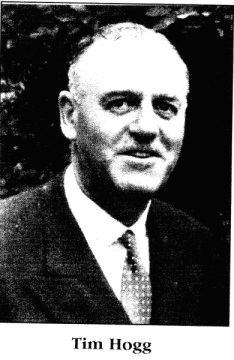
Outside the hospital,
Tim Hogg was a member of the Medical Council of
Tasmania from 1952 to 1976, a member of the State Committee of the Fair
bridge Society from 1953 to 1976; Honorary Surgeon to the Tasmanian
Turf Club; Honorary Surgeon to the Launceston Branch of Disabled
Persons; Honorary Orthopaedic Surgeon to the Society for Care of
Crippled Children from 1953 to 1971 and Vice President from 1956 to
1977. He was President of the Caledonian Pipe Band from 1951 to 1962
and Patron from 1962 until his death.
Tim Hogg received the Order of Australia (A.M.) on 26 January 1979 for
service to handicapped children.
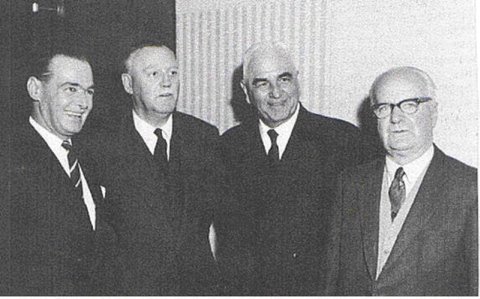
Readers may like to read other accounts of the medical personnel who laboured as members of "K" and "L" Force on the Burma Thailand Railway. Look in the articles section under "K and L Force sent to Thailand". Therein are also other short articles which relate to Tim Hogg. Much of this material was provided by one of his former Medical Orderlies Arthur Lawlor and by Mrs Joan Cussen (the widow of Robert Cussen), who after Robert's death devoted much time and effort in assembling material about the Medical support to the coolies..
Article compiled by Lt
Col Peter Winstanley OAM RFD JP
email peterwinstanley@bigpond.com
website www.pows-of-japan.net
|
|